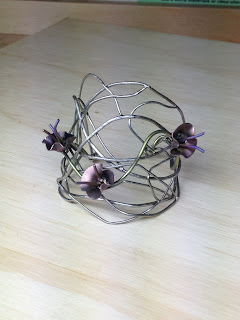Unlike
most of the students I interview for this blog, I have known Margaret
Clary for several years. We met as freshmen, when we were both new to
James Madison and unsure about our majors. She graduated this past
May with a degree in Art and a concentration in Metals and Jewelry.
When she sat down to speak with me she wore a ring that she had made
in one of her classes. She doesn't think it is anything special, but
I disagree. The ring is simple, a silver band set with a large blue
stone, and I was so impressed with it that I couldn't wait to see a
piece that she was really proud of.
 |
| Margaret's Bronze cast bracelet |
“I
prefer bracelets,” she says. “I hate wearing them, but love
making them. I just made a piece that turned out really well. I made
it in wax first, then cast it in bronze and set a stone in the
middle. It took about thirty hours, which is usually the norm.”
With
a single piece taking thirty hours, Margaret is understandably busy.
Her fascination with art began her freshman year in high school when
she took a class with her now favorite teacher, Diego Sanchez.
Although it was an art class, he also taught them art history and
style, which really helped to make the whole process more interesting
for her. When Margaret got to college she was interested in graphic
design, but because of difficulties with credit hours she switched to
metals and jewelry, and has loved it ever since.
 |
| A handmade wire bracelet with metal flowers |
“My
style is very nature-esque, I suppose. Organic. I do a lot of vine
work, and I love anything to do with flowers. I wish I had a green
thumb, but instead I bring it out in my metal work. Nature inspires
me, and I love going on walks and seeing different plants and trees.”
With
jewelry making, Margaret's favorite part is the portability of her
work. It is impractical to carry around a sculpture or a painting to
show everyone, but with jewelry she gets to wear her pieces and share
them. Getting recognition for hard work is incredibly satisfying,
especially considering how much time and effort go into a single
piece. Oftentimes, she says, people forget how much work and
dedication goes into art.
“It’s
very frustrating,” Margaret says. “A lot of people make fun of me
for being an art major, since I usually don't have regular exams and
whatnot. I don't think some people realize how much time I put into
things, and how much art means to me and other people. I've pulled
many all-nighters, and with art you can keep working and not ever
really finish.”
Several
of the students I have interviewed have said similar things, that
their artistic efforts are not always appreciated or taken seriously.
But they all say that their art has changed them.
“Metals
have definitely pushed my limits,” she says. “In my first class
we had to use torches, and I was terrified of fire! I even burned my
hair. I was pushed to do things I thought I couldn't do.”
 |
| Metal flower pendant |
Now that Margaret has graduated from JMU, she hopes to return to
graphic design. Although she would love to get more experience with
metal working, and perhaps intern with a jewelry designer, her real
passion is for graphic design. She wants to go into advertising,
hopefully staying around Richmond, where she has lived most of her
life. Whatever medium she chooses, being an artist has made an
impression on her life.
“Art
has made me notice the beautiful things around me,” Margaret says.
“I take my time and look around and enjoy how beautiful it all is.
I think art does that for a lot of people. It makes you look for the
good in everything. I know I do.”














.jpg)












